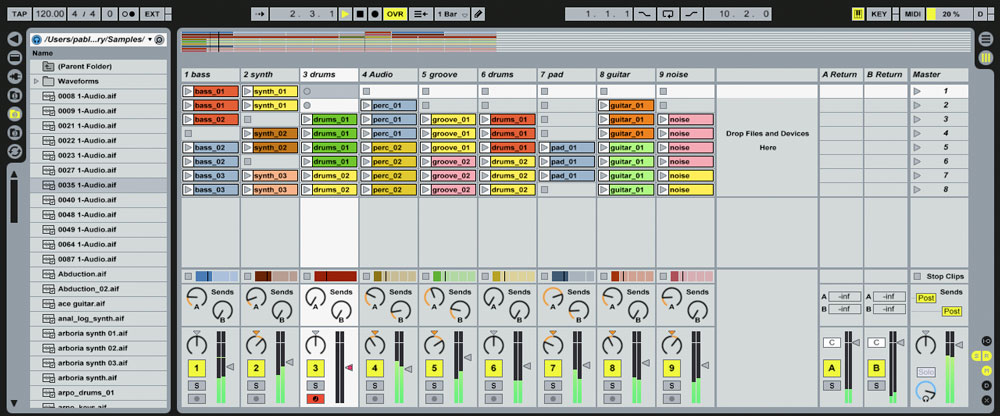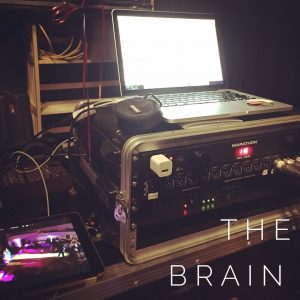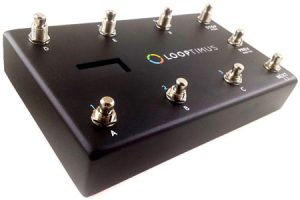Using Click Tracks and Ableton Live On Stage
Posted by Robert Reynolds on July 16th 2016

A lot of technical work goes into a Fun DMC show. The sounds you hear, the lights you see, even the arrangement of the stage, requires a good deal of preplanning and strategy.
Ableton LIVE
 Aside from our musical arrangements, we probably spend the most amount of time working in Ableton LIVE, the software program that essentially drives our live performance. Many of the songs performed by the band require complex instrumentation of a wide variety and precise timing that not only serves the song, but the visual aspect as well. Not only does Ableton LIVE “fire” our tracks, but it is also responsible for our lighting arrangements, delivering spot on scenes from song to song. This is accomplished by connecting Ableton to a MIDI controlled lighting program, DMXIS. As the song moves along its respective timeline, the lights change at certain points depending upon the dynamic of the song. This gives us complete creative control and consistency over our lighting show and helps us deliver a high energy, visually satisfying performance every time.
Aside from our musical arrangements, we probably spend the most amount of time working in Ableton LIVE, the software program that essentially drives our live performance. Many of the songs performed by the band require complex instrumentation of a wide variety and precise timing that not only serves the song, but the visual aspect as well. Not only does Ableton LIVE “fire” our tracks, but it is also responsible for our lighting arrangements, delivering spot on scenes from song to song. This is accomplished by connecting Ableton to a MIDI controlled lighting program, DMXIS. As the song moves along its respective timeline, the lights change at certain points depending upon the dynamic of the song. This gives us complete creative control and consistency over our lighting show and helps us deliver a high energy, visually satisfying performance every time.
In addition to lighting, Ableton LIVE also sends audio tracks, or loops, to the sound system. Those are the sounds you hear such as keyboards, banjo, DJ sampling and scratching, orchestral arrangements, and horn sections. In order to accomplish this, the first step is to actually create the tracks in what is known as a DAW or digital audio workstation. We typically use either Garageband or Logic Pro for this process. Both are great programs for programming, recording, and cutting up audio files. Occasionally, Audacity is necessary for some bpm (beats per minute) tweaking and modulation. Once the tracks are arranged and recorded, the tedious task of lining everything up with a click track at a certain bpm is necessary. This ensures that the band, the loops, and the lighting are all in sync with each other. Once we have completed the tracks, it is time to export them to a file folder that is connected to our Ableton LIVE show file.
Equipment
 In order to deliver high quality audio to the FOH (front of house) sound engineer, we run our tracks from a Macbook Pro via thunderbolt adapter to Firewire which runs to an audio interface. We use the Focusrite Saffire PRO 24. This allows us to physically split the digital signal into multiple analog signals. The advantage of multiple audio tracks is that it allows the FOH engineer more control over the individual instruments as opposed to merely sending one large mix of audio. The Saffire PRO has eight 1/4 inch outputs which we send to an ART P16 channel XLR patch bay. This allows us to quickly connect our cables at the front of the rack without having to fumble through the back of a rack. The final piece in this is controlling the loops at the Macbook without having to be constantly stepping over to a computer in between songs. This is accomplished through the Looptimus MIDI pedal. Created by Matt McCoy over at Loop Community, this foot controller gives us total control over every aspect of Ableton LIVE and allows the band the freedom to move from song to song seamlessly each and every night.
In order to deliver high quality audio to the FOH (front of house) sound engineer, we run our tracks from a Macbook Pro via thunderbolt adapter to Firewire which runs to an audio interface. We use the Focusrite Saffire PRO 24. This allows us to physically split the digital signal into multiple analog signals. The advantage of multiple audio tracks is that it allows the FOH engineer more control over the individual instruments as opposed to merely sending one large mix of audio. The Saffire PRO has eight 1/4 inch outputs which we send to an ART P16 channel XLR patch bay. This allows us to quickly connect our cables at the front of the rack without having to fumble through the back of a rack. The final piece in this is controlling the loops at the Macbook without having to be constantly stepping over to a computer in between songs. This is accomplished through the Looptimus MIDI pedal. Created by Matt McCoy over at Loop Community, this foot controller gives us total control over every aspect of Ableton LIVE and allows the band the freedom to move from song to song seamlessly each and every night.
